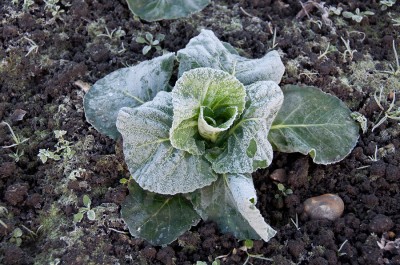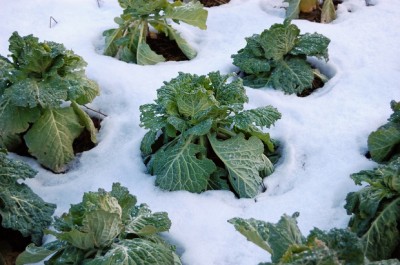If you are a gardener, this has probably happened to you. You stand up to take a break from weeding and notice that the neighbors are strapping kayaks to the top of their car. Or maybe you saw on social media that your friends are traveling across the country to an exciting vacation spot. You don’t do any of that. You’re too busy in the garden.
I’ve been there. As I stand up and stretch my aching back and wipe the perspiration from my forehead, I sometimes ask myself why I do it.
The answer is easy. I do it for the fresh vegetables. All of us intrepid vegetable gardeners do. We are so devoted to the notion of fresh vegetables — with no toxic chemicals or genetically modified anything in them and fresher than anything money can buy and all the varieties that taste better than the commercial kinds — that we go to ridiculous lengths to raise them.
And if the key to happiness is fresh vegetables, the only drawback is winter. In my latitude, the weather frowns on gardening for at least half of the year. It is true that there are plenty of canned vegetables to come between us and starvation. And we could always hit the produce section of the supermarket in a moment of weakness.
But maybe we can extend the season.
The Best Deals On Non-GMO Heirloom Seeds Are Right Here! [2]
There are plenty of ways to stretch cold-weather crops into the winter and to get a jump start on the other end. The sky is the limit, with the possibilities reaching as high as your imagination and construction savvy and budget will take you. But to get you started, here are a few basic ideas to try.
1. Choose cold-hardy vegetables. Even though we all crave fresh eggplant and tomatoes all year long, it is not possible in the far north without a pretty fancy setup that includes a heated building. Certain plants are so sensitive to cold that the first light frost can do them real damage. However, there are plenty of vegetables that can be grown, or at least maintained, in cool temperatures. Most members of the brassica family, especially kale, cabbage, Brussels sprouts, and collard greens, are pretty good at holding up to cold. Root vegetables like turnips and rutabaga and carrots and parsnips can, too. Beets and Swiss chard, close relatives to one another, are great candidates for harvesting late into fall. Spinach, some varieties of lettuce, and scallions can last into fall but can also be started in very cold spring ground.
2. Tuck a blanket in around your plants. Well, not literally a blanket, but almost. In the same way that humans and animals can keep their core temperatures warmer when wrapped in a layer of protective material — like fur or fleece or feathers or a crocheted afghan — plants can benefit from insulation as well. Layers of dry leaves work well, as does fabric row covering. The latter can be purchased in a variety of thicknesses, weights, widths, and price ranges.
Either leaves or row cover will work for protecting vegetables from cold in fall, but the better choice for spring is a lightweight row cover.
3. Cover them with a “hot jug.” It’s one of the simplest ways to get spring seedlings into the ground early. Cut off the bottom of a gallon milk jug and set it over the delicate young plant, taking the lid off the jar during the day to let it breathe. The idea is that by the time the plant outgrows the jug, it won’t need to be covered anymore.
This Cool-To-The-Touch Lantern Provides 100,000 Hours Of Emergency Backup Lighting [3]
4. Try cold frames. These are merely raised beds covered with glass or Plexiglas. People often construct them using reclaimed windows or rigid greenhouse materials. These can be so simple that you merely set a window over the edges of a raised bed, or carefully fit it with hinges so that the glass can be raised in notches to regulate the amount of air flow. The glass pieces can lay flat, or lean against another at an angle to form a peak. The end can be made of solid wood or metal, or just a piece of fabric row cover. In some locations, the end might not need to be covered at all.
Cold frames can work as a tiny greenhouse to warm the earth below the glass for starting seeds outdoors early in spring.
5. Consider low tunnels. Just like the name sounds, these are small tunnels — think miniature greenhouses. Like other methods, the options to install low tunnels run the gamut from high-tech to super simple.
Low tunnels can be built in conjunction with raised beds, or right in the ground. They can be any height you like, but are generally around two feet tall.
Low tunnel covering is usually made of greenhouse plastic when the technique is used for extending the growing season. It lets in and magnifies light and warmth, which is crucial in colder weather and for decreasing daylight hours. But the same structures can be used during the prime growing season with row cover to deter insects or with chicken wire to keep out birds, rabbits, deer or even pets.
Low tunnel ribs are available ready-made through supply catalogs, or can be constructed with PVC pipe or electrical conduit. They could even be fashioned with scrap lumber or bendable saplings, if a builder were crafty.
6. Look for warmer areas outside. If there is a warm spot on the south side of your home where the snow always melts early or where the crocuses are first to come up, consider tucking a little spring lettuce seed in there. You can lean a piece of clear roofing panel over it to further intensify the sun’s rays. There might be a wall along the outer edge of the barn that radiates animal heat, too. A plastic window well cover might work to create a nice cold-weather kitchen garden and to keep the chickens from beating you to it.
7. Bring a few plants indoors. Herbs can easily thrive in pots on your windowsill all winter long. Kale can live in pots on your unheated sunporch. And in spring, you can get a jump on the season by starting many of your seeds right in the house.
The upshot to all of this? You can enjoy fresh vegetables later in fall and earlier in spring, and in some areas even close to year-round.
And the down side? You will have to squeeze that ski trip to the Swiss Alps into a narrow window between the last of the kale and the first sprigs of new spinach. Just wave goodbye to the neighbors as you leave for the airport and they are headed out to the supermarket to settle for store-bought produce.
What winter gardening advice would you add to the list? Share your thoughts in the section below:
Learn Dozens Of All-Natural Gardening Secrets. Read More Here. [5]


